This article is meant to serve as a comprehensive guide for everything you need to know about a modern intranet.
Jump to a topic:
- Traditional vs modern intranet
- What is a modern intranet?
- Benefits of a modern intranet
- What features should a modern intranet include?
- How an intranet can improve employee experience
- Why SharePoint is not a modern intranet
- How to build an intranet
Traditional vs modern intranet
Over the past decade, we have seen a workplace evolution take place. Companies areno longer satisfied with their outdated traditional intranet platforms. Traditional intranets, although once highly innovative, simply didn’t adapt well to the modern working world.
Traditional intranets lack mobile capabilities, navigation, and social features that the modern workforce desires. Ultimately, this leads to a poor user experience.
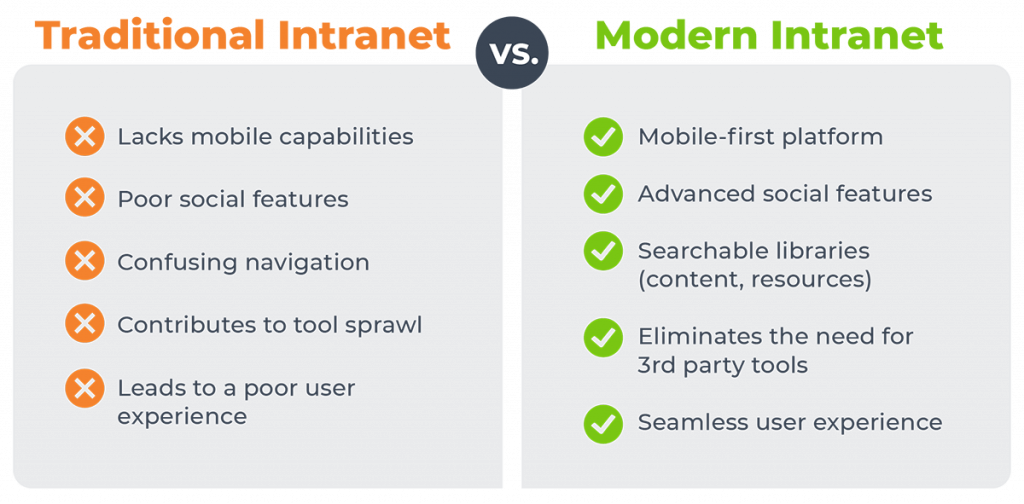
As a result of these limitations, companies relied on third-party tools to fill the gaps. However, this temporary fix has led to a whole other slew of problems, one being tool sprawl.
The demand for a solution to these piling problems was clear, leading to the creation of a modern intranet.
What is a modern intranet?
A modern intranet centralizes all the resources, tools, and information your employees need. It also provides strong collaboration and communication tools to connect your workforce. When set up effectively, it can act as your organization’s central hub for company information and news.
Unlike its predecessor, a modern intranet allows information to become searchable. Employees are then able to find the resources they need, with an individually tailored experience. It also allows employees to communicate and collaborate effectively with built-in collaboration spaces and strong social features.
For more information, learn more about the modern intranet solution by MangoApps.
Benefits of a modern intranet
Modern digital tools and intranet accessibility have dramatically changed how businesses operate and how employees within communicate.
With a modern intranet, you can take steps to improve communication, collaboration, culture, and engagement within your company.
Now, let’s dive into a few of the benefits that you can expect to see from implementing a modern intranet.
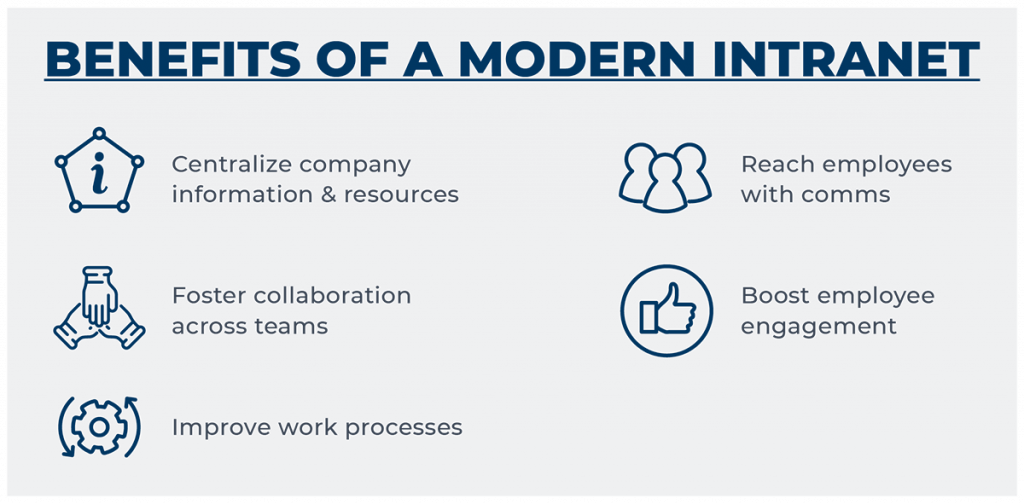
1. Centralize company information & resources
To find a specific resource, your employees have to spend a lot of time combing through email threads and jumping across tools. With a modern intranet, information, tools, and resources are stored in a centralized space. Thus, employees can quickly find what they are looking for.
To make it even easier, most modern intranet platforms will include search functionality. This can contribute to massive time savings and will boost the productivity and efficiency of your workforce.
2. Reach employees with comms
Email is not effective. Successful organizations know that emails are easy to miss, difficult to navigate, and overall, just a messy experience. A modern intranet will allow you to deliver targeted communications to your employees on the channels they prefer.
Rather than sending out mass emails or phoning employees individually, you can send content that is tailored to each employee. This helps executives make sure that their messages are being read, since their is less noise to cut through.
3. Foster collaboration across teams
Your employees can only do their best work when they have a clear agenda and instant access to the tools and information they need. With a modern intranet, you can make employee collaboration seamless and ensure projects get across the finish line.
Here are a few ways that a modern intranet helps improve collaboration:
- Keep projects on track
- Turn discussions into actionable tasks
- Get employees on the same page
- Share important knowledge and information
- Communicate in project workspaces to accomplish specific goals
4. Boost engagement & build community
With a strong social component, a modern intranet allows employees to connect with colleagues they haven’t met.
Because of this, a modern intranet helps employees forge social connections at work. This can lead to increased employee engagement and a boost in employee productivity.
By meeting and interacting with colleagues outside of your immediate team, especially in a dispersed work environment, you can bridge the gap across employees and help create a sense of connectedness.
Here are a few ways you can leverage a modern intranet to boost employee engagement:
- Gather employee feedback with surveys
- Give shout-outs to star performers
- Use recognition and rewards to boost performance
- Celebrate important milestones
- Comment on discussion threads, add emoji reactions, and use hashtags
- Use employee profiles to learn more about colleagues
5. Improve work processes
With better connectivity, a modern intranet can help your organization improve work processes. Ultimately, this cuts down on wasted time and improves productivity from your employees.
A few ways that a modern intranet can help improve work processes:
- Allow employees to connect from anywhere
- Create a centralized ‘one-stop-shop’ for employee resources, accessible via SSO
- Use search functionality to quickly locate resources
- Comment/respond/react on discussion threads rather than try to locate and respond to specific emails
- Automate workflows, forms, and manual processes
What features should a modern intranet include?
Now that you’ve learned about modern intranet benefits, let’s go over a few of the most important features.
1. Universal Dashboard
With a universal dashboard, employees can establish a quick overview of everything they need all from one location. A modern intranet will provide customizable dashboards so your employees can configure or customize their own dashboard however they please.
Examples of how employees can use their dashboard:
- Share important announcements company-wide and in real time
- Review, receive, and respond to the important company news
- Set up quick links to regularly used third-party applications
By providing your employees with a customizable dashboard, they are able to configure it to best accommodate their job responsibilities. This can go a long way in improving productivity and employee engagement.
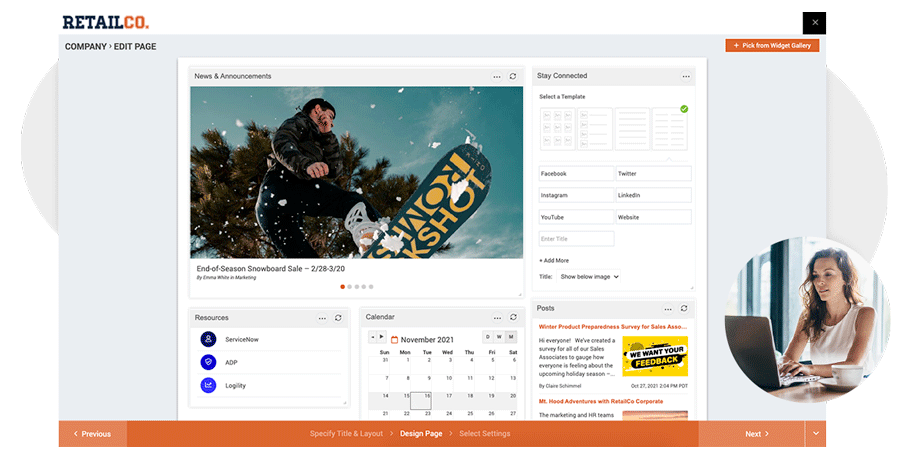
2. Team Workspaces
With team workspaces you can get projects across the finish line quickly and ensure that nothing falls through the cracks. Employees are able to seamlessly collaborate. By having a clear understanding of what their peers are working on, they become more efficient.
Why your employees will love team workspaces:
- They are able to stay on the same page with their team members
- They can quickly distribute and oversee action items and tasks
- Improve sense of community among groups of colleagues
- They can view a team calendar that clearly details the availability of colleagues

3. Mobile App
Today’s employees no longer work stagnant 9-5 jobs entirely out of office chairs. Our modern workforce is remote and on the go. It is critical that your company’s intranet reflects this as well.
A mobile app offers unfettered access to company resources and conversations. It also allows employees to stay connected from wherever they are.
A mobile intranet offers convenience, but more importantly, it offers inclusion to frontline employees.
With a mobile app, you can begin bridging the communication gap between your frontline and desk employees. This improved access creates a space for every employee to be happy and successful at work.

4. Content Management System
A Content Management System (CMS) provides a secure, central space for employees to access company resources.
Rather than disrupting their workday trying to locate a resource, your employees can quickly find what they need. This improves productivity and employee engagement as they are no longer occupied with what was once a time-consuming task.
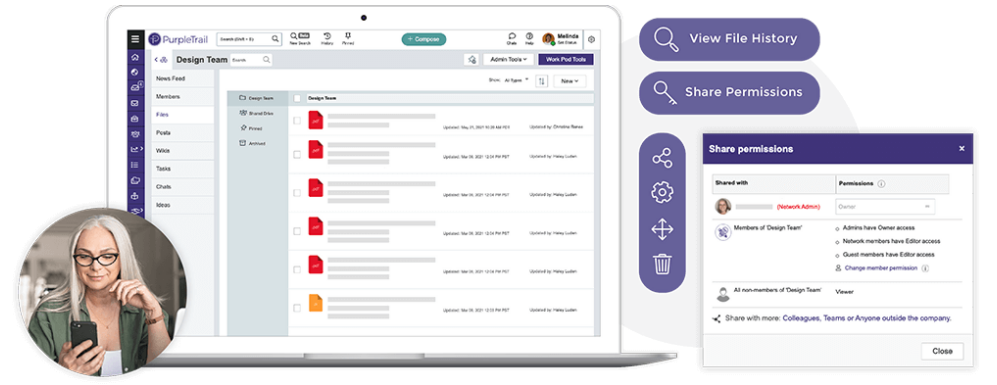
Read more about the features your modern intranet should include.
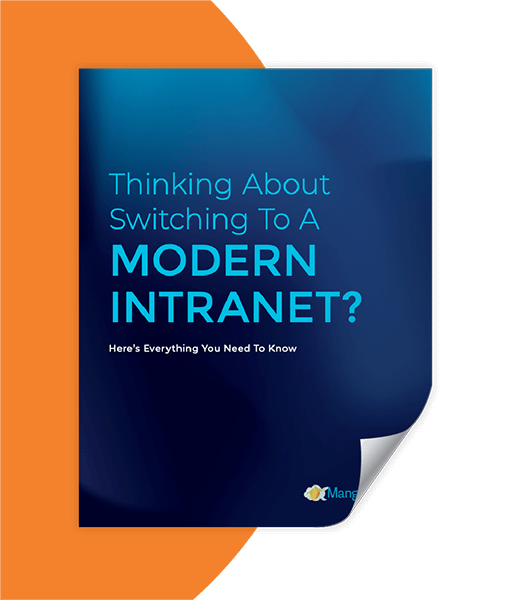
Switch To A Modern Intranet
Learn about the benefits of switching to a modern intranet, and why it’s never too late to start building a better digital workplace.
Get your free eBook today!
How a modern intranet can improve employee experience
Equipping employees with the tools they need to do their job is at the forefront of every business leader’s mind. A modern intranet yields many intangible benefits that are difficult to measure but have a dramatic impact on organizational success.
In addition to better communication, increased productivity, cost-savings, and more, a modern intranet can also improve your overall employee experience.
Below we discuss a few ways that a modern intranet can improve employee experience at your company.
Improve productivity
With a centralized space for communication and collaboration, employees no longer need to resort to sifting across third-party tools to find what they need.
Instead, they are granted access to a ‘one stop shop’ for everything they need to do their jobs. A modern intranet allows them to optimize efficiency, improve productivity, and save time by finding things quickly.
In addition, typical modern intranets include a mobile app, allowing employees to respond and collaborate from anywhere.
Give every employee a voice
Employee engagement is a focus for every organization. You want your employees to feel valued, involved, and fully invested in the organization.
A modern intranet ensures that everyone on your team has a chance to contribute and be heard.
Some features that can assist with this effort are employee surveys, employee recognition, team/department workspaces, and more.
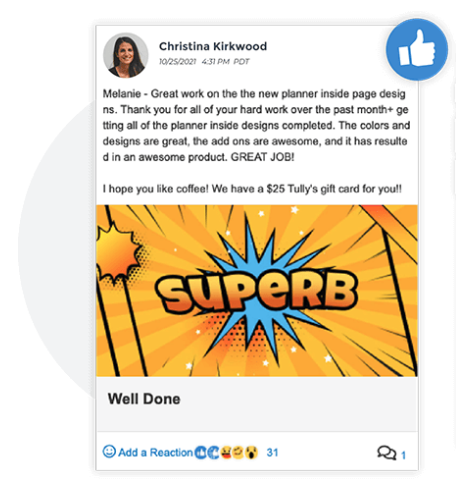
Create a workplace community
Company culture can play a massive role in employee retention and overall job satisfaction.
A modern intranet provides colleagues with a social space to engage, communicate, and collaborate with each other. You can connect with people that you don’t normally interact with due to distance or work schedule.
In doing this, you can create an environment where employees are aligned, working together to achieve a common goal.
Build company ambassadors
Your employees are the faces of the organization. It’s critical to create a positive work environment where they can succeed and are satisfied with their daily work. Over time, these employees can become company ambassadors and represent public advocates for your brand.
A modern intranet equips you with the tools you need to create a positive workplace environment. It provides a collaborative space where colleagues interact more and everyone understand how they contribute to the company vision.
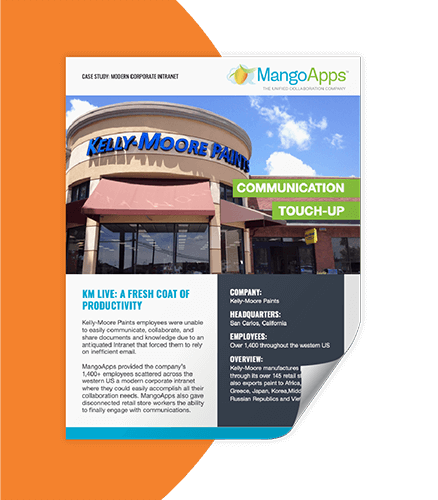
Kelly-Moore Paints Case Study
Learn how Kelly-Moore Paints:
- Improved employee efficiency
- Increased the level of communication between employees
- Encouraged a cohesive and inclusive company culture
Why SharePoint is not a modern intranet
Although SharePoint has some features of a modern intranet, it is limited in many aspects. It does not offer a unified employee experience in the same way that a modern intranet does.
The main purpose SharePoint serves is as a content management system for files and records. If your organization wants functionalities beyond that, it will require heavy investment and custom development.
A modern intranet isn’t just a repository for documents and resources. It’s a mobile-first employee communications and engagement platform.
Here are a few reasons SharePoint is not a modern intranet, and you should consider other vendors.
SharePoint is difficult to use
SharePoint historically has had low employee adoption rates. This is due to it being difficult to use for end-users and difficult to manage for administrators.
Did you know?
Up to 72% of SharePoint implementations fail to meet their desired goal and are abandoned.

SharePoint was ultimately created as a platform to store and manage documents and files. The rest of the platform was not built to provide a centralized employee experience. This leads to low adoption and a poor user experience.
Deskless employees don’t have access
Another reason why you should avoid SharePoint is that only desk workers can use it effectively.
More often than not, only office workers will have 0365 licenses, and frontline/deskless employees don’t. This means that you will be deploying a limited intranet that only connects some of your staff. As such, you’ll have to make heavy investments elsewhere to get additional licenses and software.
A modern intranet provides a seamless employee experience for ALL of your organization’s workers. Employees can connect from anywhere, at any time, and are not confined to the physical limitations of their desk.
Limited features
SharePoint was built as a content management system designed for storing documents. As a result, it lacks many of the elements that are needed for an employee-centric intranet.
Some of the limitations of SharePoint features include:
- Poor employee experience
- Lacks personalization & filtering
- Doesn’t work well on mobile
- Poor multi-channel communication
- Limited content governance capabilities
- Doesn’t allow for audience segmenting and targeting
- Doesn’t offer deep analytics & insights
In addition to all these limitations, SharePoint also comes with a very slow deployment process and requires a heavy IT investment.
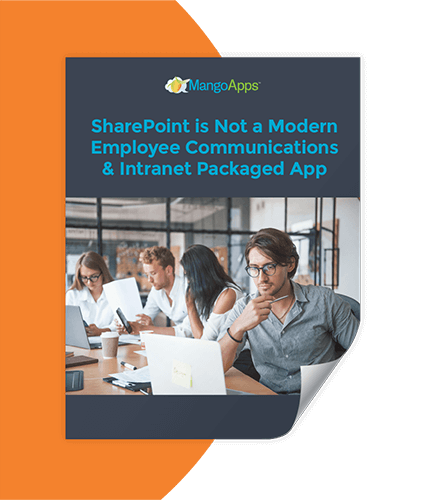
Learn more about the limitations of SharePoint
View this whitepaper to learn more about the limitations of SharePoint, and how a modern intranet platform might be a better fit for your organization’s needs.
How to build an intranet
A great intranet platform gives employees all the tools and resources they need to collaborate and be productive.
To accomplish that, you first have to select an intranet vendor that will set your employees up for future success.
Doing this can seem quite daunting, so we have laid out a detailed 10-step process that covers everything you need to know about intranet best practices.
Additional Resources
For more information related to modern intranets, read our list of questions to ask in an intranet demo, ways to boost intranet engagement, see some great intranet design examples, or read case studies from our customers TeamHealth, symplr, and Great Harvest Bread.







